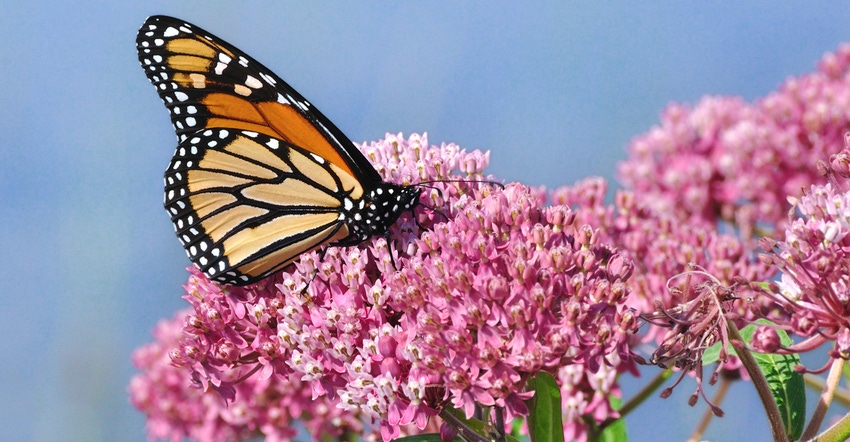
Living on a farm, my mother recalls robust patches of milkweed along fencerows and in ditches. She had fun playing with them after they’d gone to seed, plucking fuzzy pods and blowing an abundance of seeds around — undoubtedly helping to spread its population.
Today, milkweed has become scarce. That’s a problem for many reasons, and farmers should be concerned. Here’s why.
Milkweed is the only plant monarch butterflies use to lay eggs and the main source of food for baby caterpillars.
The butterfly is known for its annual, multi-generational migration from Michigan and even Canada to Mexico. Monarch butterflies depend on milkweed to lay their eggs during the journey, as the caterpillars only eat milkweed. If monarch eggs are laid on plants other than milkweed, the caterpillars starve to death.
The U.S Fish and Wildlife Service recently disclosed that since 1990, around a billion monarchs have vanished.
Farmers should be concerned because their numbers have dropped to the point where FWS is considering a petition to list the species as endangered in June 2019.
The Endangered Species Act has broad authority to restrict activity to prevent “take” (killing, harming, hunting, trapping or harassing) of an endangered species. This includes altering its habitat, which for an insect could include spraying for weeds, mowing, plowing, grazing or making other land-use changes that would cause harm to an endangered species if it is found on your property.
Even if it is not found on your property, any involvement with federal agencies, including easements, permits, farm bill program enrollment or others, could require consultation with FWS for any lands in the species’ identified range.
Listing the monarch as endangered across its huge range (more than half the U.S., including Michigan and Ohio) could severely restrict farm activity.
In addition to loss of breeding and food habitats along the way, the significant decline in the overwintering population in Mexico as compared to the 20-year average may be attributed to forests in Mexico being torn down. And warmer weather is confusing butterflies, which wait for cold temperatures to begin their annual migrations. There’s also predators, pathogens and parasites that are threats beyond our control.
Plant some milkweed
There is something you can do to potentially ward off an endangered species listing for the monarch. Landowners and farmers can participate in one of the pollinator-protection programs offered by the Farm Service Agency under the Conservation Reserve Program.
In January, a program from the the Natural Resources Conservation Service started. NRCS will offer financial assistance through the Environmental Quality Incentives Program Monarch Habitat Initiative for implementing designated practices to create or improve monarch habitat.
Practices include conservation cover, field borders, prescribed burning and brush management. Local NRCS conservationists are ready to work with private landowners to create habitat for pollinators on nurseries, farms, orchards and forests.
Applications for conservation financial assistance are accepted on a continuous basis. Submit them to local field offices or using the Conservation Client Gateway.
On designated dates, applications are ranked and selected for funding. The first ranking for 2018 applications was in January, but additional rankings are expected. For more information on how to apply for financial assistance, contact your local NRCS field office
Besides being great pollinators, Monarchs — “the king of butterflies” — are just pretty and a delight to see. Their orange and black ribbed body is accentuated with white polka-dots. Who wouldn’t want one to land on his or her shoulder?
So plant some milkweed. It’s a beneficial wildflower. It may have “weed” in the name, but there are over 100 species of milkweed native to the U.S. and none of them are considered “noxious weeds.”
Monarch’s life cycle
A monarch's life is a story of transformation. It starts as an egg, and within a few days, emerges as a ravenous caterpillar. After 10 to 14 days of munching away at milkweed leaves, the monarch forms a chrysalis.
Over the next two weeks it undergoes a radical reorganization of its tissues, ultimately tearing free from its confinement as an adult monarch butterfly. If hatching in the summer, it may live for an additional two to five weeks.
In early fall, the final generation of monarchs migrates from Canada, Michigan and Ohio all the way to the Central Highlands of Mexico to overwinter in large aggregations on fir trees at high elevations. This special generation may live up to eight months.
The next spring, those same individual butterflies return to the southern United States where they lay eggs on milkweeds before dying, and the cycle starts again.
About the Author(s)
You May Also Like






